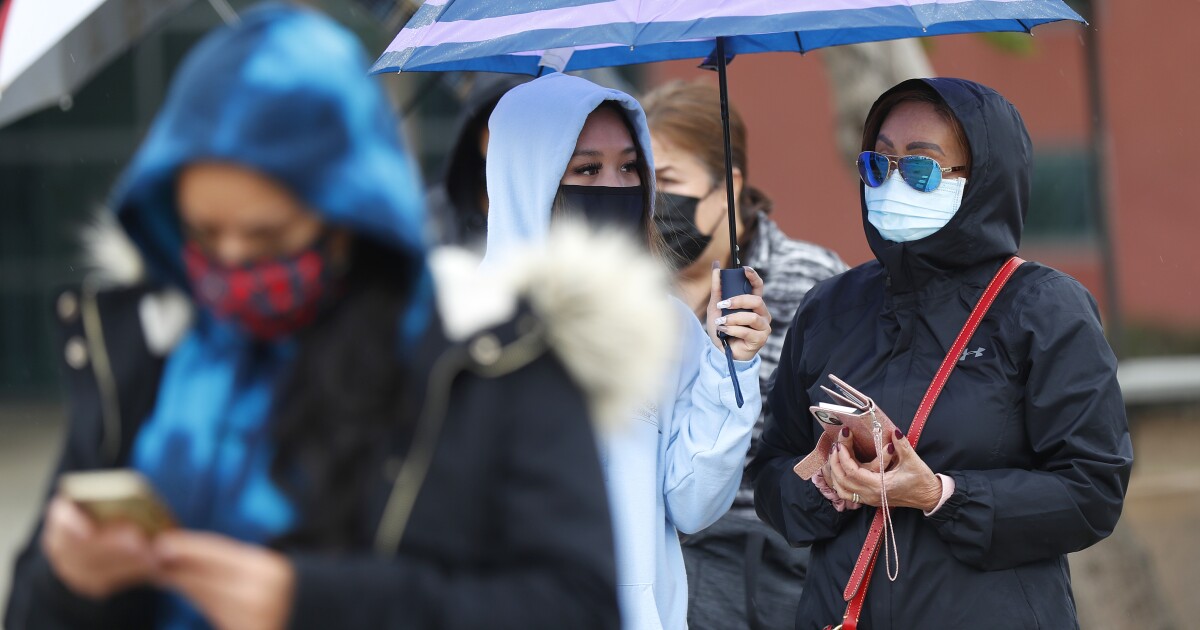San Diego County has created a COVID-19 alert system. Does he pay attention to danger signs?
[ad_1]
In June 2020, the San Diego County Public Health Department adopted a set of 13 triggers designed to signal that the coronavirus pandemic was worsening and that additional measures were needed to regain control of viral transmission.
Eighteen months later, six of those indicators are in the red, enough to trigger a change in existing health orders. But there is no indication that anyone in the county government intends to make any changes, even as the region has a record number of new cases and emergency rooms are inundated with patients positive for the coronavirus.
This story is for subscribers
We offer subscribers exclusive access to our best journalism.
Thank you for your support.
Why hasn’t the region’s public health authority made any changes when its own triggers have flipped?
Neither Dr Wilma Wooten, the region’s public health official, nor any of his deputies answered the question directly last week. The county communications office said in a short note, not attributed to anyone in particular, that the county “constantly monitors and uses the trigger metric to inform local decision-making,” but “decisions are made on the basis of base of all information, â€including knowledge gained long after the triggers were first designed 18 months ago.
Rather than altering its list of triggers, local public health authorities have generally followed state guidelines, at least at the pandemic policy level. County supervisors did not respond when asked through their communications officers to comment on the situation.
Anyone can see that the pandemic landscape has changed dramatically, with the advent of an effective vaccine adding a mountain of hope to the picture. This key element appears to be a major factor in the health service‘s reluctance to make major changes – such as reinstating trade restrictions – as its trigger warning system has sent red flags.
“San Diego County has since grown into one of the most vaccinated populations in the state and the number of hospitalizations is well below 12 months, along with the rollout of emerging treatments for those most at risk,” indicates the county press release.
Other major California metropolitan areas have been more energetic in recent months.
Los Angeles and San Francisco, after keeping masking rules indoors when they fell in most communities across the state this summer, both instituted proof of vaccination requirements for bars, gyms, restaurants and other places accessible to the public, although anecdotal reports of uneven application have raised many questions about their effectiveness.
The latest figures do not seem to suggest that San Diego has suffered from its more open approach, as the arrival of a more contagious variant of Omicron has caused cases to skyrocket. Since Saturday, the state’s coronavirus website LA listed with a case rate of 76 per 100,000 population, with San Francisco reaching 69 and San Diego 64.
So far, California’s pandemic position has remained much more open than it was in late 2020 and early 2021. A wide range of businesses and locations have remained open as cases increased.
But momentum is building within academia towards a more aggressive approach, especially as reports of overwhelmed hospitals continue to surface in communities across the country.
Two weeks ago, two Harvard professors urged Dr Rochelle Walensky, director of the Centers for Disease Control and Prevention, in a letter later shared online, to consider short-term closures to slow the spread of the virus “with the narrow aim of avoiding catastrophic hospital overload and the preventable death and suffering that would otherwise ensue,” when rates of High infections generate more admissions than can be handled.
Often referred to as “circuit breaker” shutdowns, the idea sparks significant debate in the UK, with a group of researchers modeling the effects of a two week break from most activities in places where case rates are increasing very rapidly. Research results revealed that such a shutdown, if a large enough segment of the population complied with it, could function as a kind of ‘time reset’, breaking the chains of person-to-person transmission for long enough to make it happen. that the number of recent infections, hospitalizations and deaths could be drastically reduced.
So far, however, there has been little response to the US call for any kind of shutdown.
In San Diego County, the path is more visible than in most cities due to the formalized trigger system which states that “the order of the health officer will be changed” when certain parameters no longer comply. This week alone, a new indicator that shows how quickly local hospital beds are filling has turned red. The trigger is considered normal as long as the percentage of locally hospitalized COVID-19 patients increases at a rate of less than 10 percent, a number that is calculated by comparing the subsequent three-day averages of overall hospitalization for all non-centers. military medical officers in the region.
Last week, the growth rate was listed at minus 4.5, meaning the number of hospital patients with confirmed cases of COVID-19 was declining. Last week, the number skyrocketed, hitting 19.7% in just one week. The spike coincided with a crush of residents arriving at local emergency rooms, forcing many facilities to temporarily divert ambulance traffic even though most would have mild illness and some appeared to be trying to shorten the long lines of ambulance. waiting in test centers.
Other triggers such as the local case rate, the number of outbreaks in the local community, the number of people with symptoms of COVID-19 or flu-like, and the percentage of new cases reported. timely investigation by the health department were all in the red.
[ad_2]


Comments are closed.